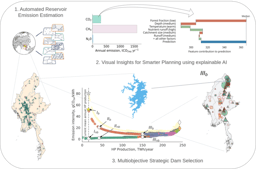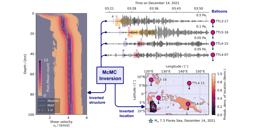The Arctic Ocean is undergoing significant changes due to global warming, which has important implications for its ecosystems. As sea ice retreats, shifting seasonal cycles and changing environmental conditions create new challenges for the species that inhabit this fragile region. To better understand the ecological dynamics of these rapidly evolving ecosystems, our team developed an integrated approach to analyze species co-occurrences, reconstruct potential ecological communities, and reveal the interactions that drive these communities.
The Vision: From Co-occurrence to Interaction Discovery
Our project aimed to move beyond traditional statistical descriptions of amplicon data. We focused on not only identifying which organisms are present but also understanding how they interact with one another and how these interactions influence community structure over time. We are convinced that a deeper analysis can provide insights into how Arctic ecosystems respond to environmental changes.
To achieve this, we employed a multidisciplinary approach, integrating biology, computer science, and mathematics. We reviewed the scientific literature to find methods that would help us capture these interactions. A key method for our paper is the Convergent Cross Mapping (CCM) approach, developed by George Sugihara, which allows for inferring causal relationships from time-series data.
Beyond Linear Relations: A New Way to Measure Interactions
One significant insight from our research was the notion that interactions among Arctic organisms are highly non-linear. Traditional methods like Pearson correlations, which assume linear relationships, were not sufficient for capturing the complex dynamics we were studying. Instead, we treated each abundance time series as a distribution and opted for Normalized Mutual Information (NMI) as a more appropriate measure. NMI quantifies the shared information between two time series while accounting for asymmetry, allowing us to determine the direction of potential interactions.
With these analytical foundations established, we could track species co-occurrences, identify interactions using CCM and NMI, and cluster organisms into communities using Louvain clustering, a method for detecting modular structures in large networks. However, we realized that we also needed to assess the stability of the communities we were analyzing.
Adding Stability to the Mix: Energy Landscape Analysis
This is where we turned to Energy Landscape Analysis, developed by Kenta Suzuki. This approach allowed us to evaluate the stability of different community configurations. By analyzing the "energy" of specific groups of organisms, we could identify communities that were highly interconnected and resistant to changes. Organisms meeting these stability criteria, which co-occur with others and engage in complex interactions, were categorized as keystone species—critical contributors to their ecosystems.
Testing Our Approach: 96 Samples, Four Years, and the Fram Strait
To validate our approach, we applied our methods to a unique dataset: 18S rRNA gene amplicon data collected over four years from the Fram Strait, where the Arctic meets the Atlantic. This dataset included 96 samples, capturing seasonal cycles of eukaryotic organisms, from phytoplankton to small protozoa. The Fram Strait is known for its distinct seasonal patterns, making it an ideal location to study Arctic microbial communities.
Our analysis yielded several important findings, particularly a phenomenon we termed the "winter reset". Each winter, as conditions become harsh, microbial communities appear to reset, creating a blank slate from which the spring bloom emerges. This indicates that the composition of the spring bloom is largely influenced by conditions during winter, when only the most resilient species survive.
The Winter Reset and Atlantification
In addition to uncovering the winter reset, our analysis provided insights into the potential impact of Atlantification—the northward movement of warmer Atlantic waters into the Arctic. Interestingly, our results suggest that winter communities, adapted to extreme conditions, may be better equipped to handle these changes compared to summer communities. This could have implications for the resilience of Arctic ecosystems amid ongoing climate change.
Building the Future: The Birth of "Otter"
Our research not only generated new scientific insights but also laid the groundwork for future tools and collaborations. Throughout the project, we developed a dynamic community analysis tool called Otter. This tool integrates the various methods we applied, from co-occurrence networks to energy landscape analysis, making it easier for researchers to study community dynamics across different ecosystems. With support from the **Ilove** funding program at the Alfred Wegener Institute, we are continuing to refine Otter and expand its capabilities.
Looking Ahead: Linking More Trophic Levels and Expanding the Winter Reset
While our current study focused on eukaryotes, we plan to broaden our research. One of our next steps is to incorporate additional trophic levels—such as viruses, prokaryotes, and zooplankton—into our community analyses. By expanding the scope of our research, we aim to better understand how different layers of the Arctic food web interact and respond to environmental pressures.
We also intend to explore the winter reset phenomenon further. Understanding how Arctic ecosystems "reset" during the polar night could be crucial for predicting their responses to ongoing environmental changes, such as rising temperatures and shifting ocean currents.
Conclusion: A New Era of Arctic Ecological Analysis
Our study demonstrates the value of integrating multiple analytical approaches to understand the complex dynamics of Arctic ecosystems. By combining co-occurrence networks, convergent cross-mapping, and energy landscape analysis, we have made significant progress in understanding how microbial communities in the Arctic interact and adapt to change. These insights not only enhance our knowledge of Arctic biodiversity but also provide essential tools for predicting how ecosystems may respond to future shifts in their environment.
The Arctic Ocean is changing rapidly, and with innovative approaches like ours, we aim to improve our understanding of its ecological dynamics—one reset at a time.





Please sign in or register for FREE
If you are a registered user on Research Communities by Springer Nature, please sign in